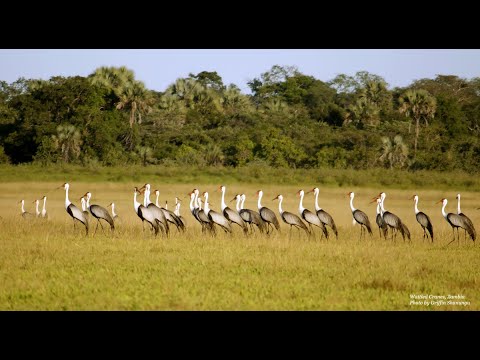Summary:
1. The Restoration of an African Haven: Exploring the Efforts to Preserve the Kafue Flats in Zambia for Wildlife
2. Understanding the Threat of Invasive Species: How Mimosa Pigra Endangers Native Plants and Animals
3. The Collaborative Efforts: Working with Local Communities to Combat the Invasive Plant Species and Protect Wildlife
The Restoration of an African Haven: Exploring the Efforts to Preserve the Kafue Flats in Zambia for Wildlife
In the heart of Zambia, along the banks of the mighty Kafue River, lies a haven for Wildlife known as the Kafue Flats. This vast wetland offers a unique and diverse ecosystem, supporting many species, including the majestic Wattled Cranes. However, in recent years, the tranquility of this African paradise has been threatened by the invasion of an insidious plant species – Mimosa pigra. This invasive tropical shrub has been rapidly spreading and choking the wetlands, jeopardizing the delicate balance of this precious habitat.
Understanding the Threat of Invasive Species: How Mimosa Pigra Endangers Native Plants and Animals
The invasion of Mimosa pigra in the Kafue Flats poses a significant threat to the native plants and animals, including the iconic Wattled Cranes. This invasive species can reproduce and spread quickly, outcompeting native plants for resources such as sunlight, water, and nutrients. Its dense growth forms impenetrable thickets, destroying the open areas and marshes essential for the survival of numerous plant and animal species.
Furthermore, Mimosa pigra alters the physical characteristics of the wetland, affecting water flow and sedimentation patterns. The shrub’s extensive root system contributes to the siltation of water bodies, potentially disrupting the breeding grounds of aquatic organisms and reducing water quality. The invasion also poses a fire risk, as the plant’s dry vegetation can easily ignite, threatening the local Wildlife and human settlements nearby.
The Collaborative Efforts: Working with Local Communities to Combat the Invasive Plant Species and Protect Wildlife
Recognizing the situation’s urgency, a dedicated team of conservationists, researchers, and volunteers embarked on a collaborative mission to combat the spread of Mimosa pigra in the Kafue Flats. Their endeavor involved removing the invasive shrub, raising awareness, and engaging with local communities.
The first step in this ambitious project was to gather comprehensive data about the distribution of Mimosa pigra. By conducting thorough surveys and mapping the extent of the invasion, the team identified priority areas for intervention. Armed with this knowledge, they implemented control measures, including mechanical removal, manual uprooting, and biologically safe herbicides.
However, the success of this restoration project relied heavily on the involvement and support of the local communities. Recognizing the mutual benefits of preserving their natural heritage, the team worked closely with the people living in and around the Kafue Flats. Community engagement programs were established, focusing on educating individuals about the impacts of invasive species and the importance of biodiversity conservation. The team fostered a sense of ownership and cooperation among the locals through workshops, field trips, and interactive sessions.
The collaborative efforts have yielded encouraging results. By removing Mimosa pigra from the wetlands, the team has restored the much-needed open areas vital for the survival of Wattled Cranes and other Wildlife. The wetlands now provide these unique bird species’ with necessary feeding and breeding grounds. Additionally, with the revival of the wetland ecosystem, many other plants and animals have benefited, contributing to the overall biodiversity and ecological balance of the Kafue Flats.
The restoration project in the Kafue Flats is a powerful example of the value of collaborative conservation initiatives. By bringing together experts, local communities, and partners, it demonstrates the tangible impact that can be achieved in protecting and restoring our natural heritage. Moreover, it highlights the urgent need for proactive measures and ongoing monitoring to prevent the further spread of invasive species and safeguard our fragile ecosystems.
In conclusion, the restoration of the Kafue Flats in Zambia is a testament to human determination and the resilience of nature. The invasive Mimosa pigra has been successfully combated through a concerted effort, allowing the wetlands to thrive again. This endeavor serves as a reminder of the importance of preserving our habitats and the crucial role each individual can play in safeguarding our planet’s unique and irreplaceable Wildlife. Let this inspire us all to take action and make a difference in conserving our natural world.
*****
Source Description
Invasive species threaten native plants and animals, including cranes, worldwide. In the Kafue Flats of Zambia on the Kafue River, our team worked with local communities and partners to remove Mimosa pigra. This invasive, tropical prickly shrub is choking wetlands needed by Wattled Cranes and other Wildlife.

